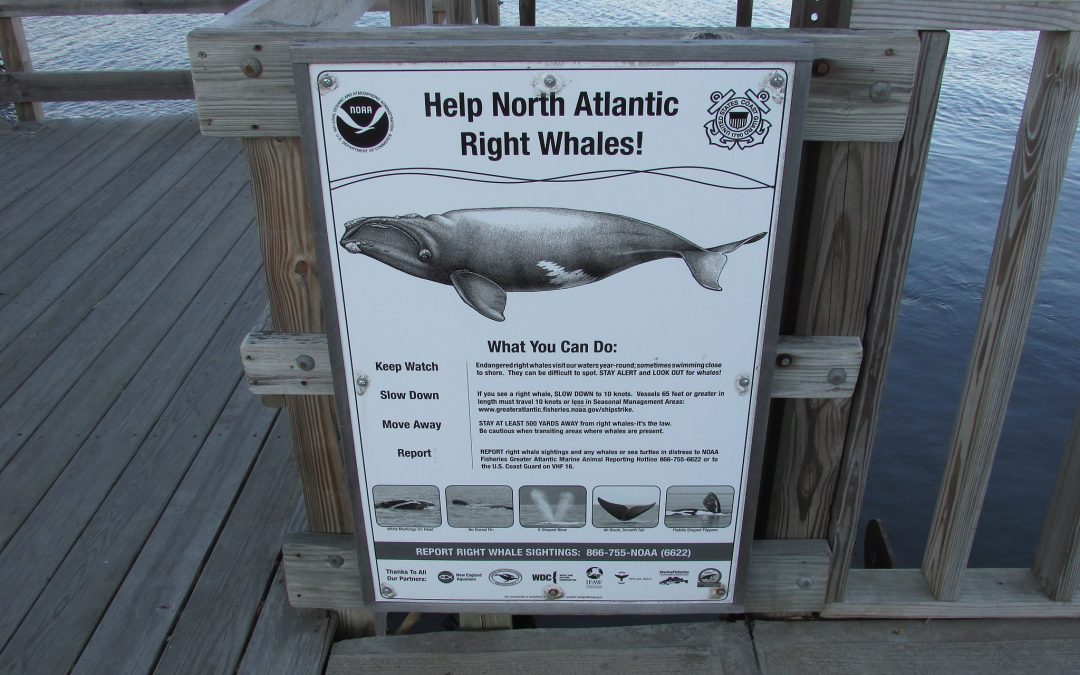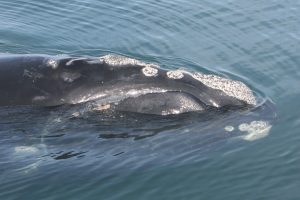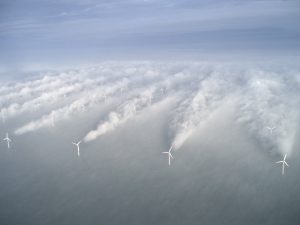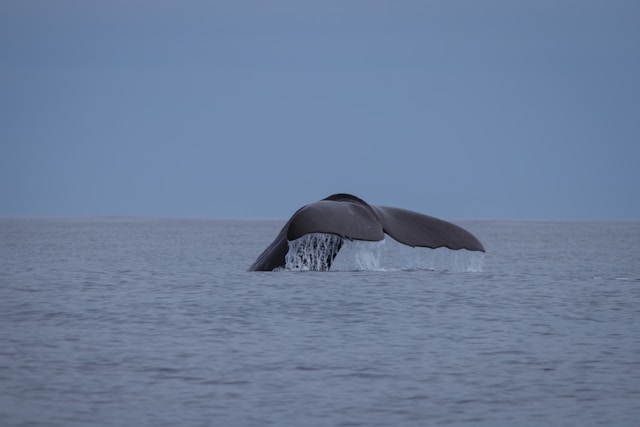
by DGR News Service | Nov 25, 2022 | ACTION
By Carl van Warmerdam
The North Atlantic Right Whale (NARW) are among the rarest of all marine mammal species in the Atlantic Ocean. They average approximately 15 m (50 ft) in length. They have stocky, black bodies with no dorsal fin, and bumpy, coarse patches of skin on their heads called callosities. The NARW is one of the world’s most endangered whales. Once common along the eastern U.S. seaboard, the whale was hunted to near-extinction by the 1750s. The species gets its names from early whalers, who considered them to be the “right” whales to hunt. By the early 1900s the population off Europe had been virtually extirpated while a small population of perhaps a hundred or fewer survived in the western North Atlantic off the United States and Canada. After 1935, when an international agreement went into effect banning the hunting of all right whales, their numbers began to increase slowly. In recent decades, this slow recovery has been impeded by mortality and serious injury from ship strikes, entanglement in fishing gear, underwater noise and separation from calving areas because of shipping traffic. NARW now occur almost exclusively along the east coasts of the United States and Canada, where they rely on a calanoid copepod, Calanus finmarchicus, as their primary food source. Beyond eating a lot, whales also produce lots of plumes (a gassy form of underwater poop). These plumes fertilize the ocean and help feed small organisms called phytoplankton. These organisms, in turn, produce 50% of the world’s oxygen – every other breath humans take. Over their lifetimes, NARW also accumulate tons of carbon in their bodies – helping to mitigate climate change. The importance of whales for the ecosystem cannot be overstated.
An 8-year analysis of NARW sightings within Southern New England (SNE) show that the NARW distribution has been shifting (Quintana- Rizzo et al. 2021). A study area of SNE (shores of Martha’s Vineyard and Nantucket to and covering all the offshore wind lease sites of Massachusetts and Rhode Island) recorded sightings of NARW in almost all months of the year. A population trend analysis conducted on the abundance estimates from 1990 to 2011 suggest an increase at about 2.8% per year from an initial abundance estimate of 270 individuals in 1998 (Hayes et al. 2020). However, modeling conducted by Pace et al. (2017) showed a decline in annual abundance after 2011, which has likely continued as evidenced by the decrease in the abundance estimate from 451 in 2018 (Hayes et al. 2019) to 412 in 2020 (Hayes et al. 2020). This decrease correlates to when the Block Island wind turbines were constructed. The only offshore wind Turbines in the Americas.
With an estimated population of fewer than 350 individuals, scientists have been raising the alarm about the dwindling number of reproductive females needed to sustain the population. For a new paper published in the journal Frontiers, lead author Joshua Reed, a PhD candidate from the School of Natural Sciences at Macquarie University, used individual female whales’ reproductive history, rather than age, when modeling population trends to provide a better insight into their numbers. “Our research found that of the estimated 142 female right whales alive in the population at the beginning of 2018, only 72 were actually capable of reproducing. This has certainly influenced the species’ decline in recent years,” said Reed. The researchers also found that in recent years, young females are less likely to start calving when they reach 10 years of age. Ten was the age at which right whales used to have their first calf in the years up to the turn of the century. Right Whales can and should live for up to 75 years. But that number is quickly declining. Scientists identify individual right whales through photographs and compare these images throughout time to learn about their lifespan. And, according to recent estimates, female right whales are barely making it to middle age. But many right whales don’t even make it that far.
In its 2020 update of its “Red List of Threatened Species,” the International Union for Conservation of Nature declared NARW “critically endangered,” the most serious category of risk, with such a small, slow-growing population, any threatening factor may have a significant impact.
Offshore Wind or North Atlantic Right Whale?

“North Atlantic right whale” by FWC Research is licensed under CC BY-NC-ND 2.0.
The Bureau of Ocean Energy Management (BOEM) plans, by 2025, to hold up to five additional, to the Revolution Wind, Offshore Wind (OSW) lease sales and complete the review of at least 16 plans to construct and operate commercial OSW facilities, which would represent more than 22 gigawatts of “clean” energy for the nation. That means thousands of wind turbines along the Eastern Seaboard.
BOEM and the National Oceanic and Atmospheric Administration (NOAA) Fisheries initiated development of a shared Draft North Atlantic Right Whale and Offshore Wind Strategy (hereinafter called “Strategy”) to focus and integrate past, present, and future efforts related to NARW and OSW development. In response to Executive Order 14008, both agencies share a common vision to protect and promote the recovery of NARW while responsibly developing offshore wind energy. The announcement initiated a 45-day public review and comment period on the draft strategy. Comments on the guidance can be submitted via regulations.gov from October 21 to December 4, 2022 under Docket Number BOEM-2022-0066. For more information about the draft strategy and how to submit comments, visit BOEM’s website.
The following is my comment. Please use this opportunity to express your concerns in this regard.
The NARW species provides important ecosystem services, and its potential extinction could be a leading indicator for other ecosystem disruptions (Pershing et al. 2021). The extinction of the Right Whale will be the precursor of the extinction of our own species. Both will be caused by the disturbances to functioning ecosystems by human expansion. And it does not need to be this way. OSW development will result in the destruction or adverse modification of designated critical habitat. Only a “jeopardy” or “adverse modification” conclusion can be reached. Whales and turbines do not mix. Please do not allow this “development” to proceed while the NARW survival is in the balance. There is still time, but the time is now because there is so little left.
Climate change does in-fact pose a significant global threat that will cause planet-wide physical, chemical, and biological changes that substantially affect the world’s oceans, lands, and atmosphere. But climate change is a symptom of industrial civilization and driven by the disease of a consumer culture. A new study finds a 69% average drop in animal populations since 1970. Over those five decades most of the decline can be traced to habitat destruction. The human desire for ever more growth played out over the years, city by city, road by road, acre by acre, across the globe. “Biological diversity is the variety of life on Earth and the natural patterns it forms. The biodiversity seen today is the result of 4.5 billion years of evolution and, increasingly, of human influence as well. It forms the web of life, of which humans are integral and upon which people and the planet so fully depend. The planet is currently in biodiversity breakdown. Species are now disappearing hundreds, or even thousands, of times faster than the natural background rate of extinction. The scientific community has repeatedly sounded the alarm on the triple planetary crisis of climate change, nature and biodiversity loss, and pollution and waste. Over half the world’s total GDP is moderately or highly dependent on nature, which also provides medicine and social benefits.” We are in a biodiversity emergency. With scores of species dying each day, we are in a mass extinction event. Although many of those species may not be as impressive as the megafauna they are just as important to protect the complex balance of nature which all of life is dependent upon.
Without significant reductions in anthropocentric consumption of the natural world, greenhouse gas emissions, extinctions and transformative impacts on all ecosystems cannot be avoided. Our options in what reductions will then be impose by such limits will create harsher impacts on the economic, recreational, and subsistence activities they support.
OSW is abundant and renewable but extracting that energy with turbines will be neither efficient or clean or an alternative domestic energy resource. Wind turbines are not renewable. Heavy industries use a lot of energy to create the components for wind turbines. Coal and other fossil fuels are utilized to power the machinery and furnaces in these factories. According to estimates, the energy utilized by the present United States’ heavy industries is equivalent to the energy necessary to power the country’s entire electrical grid.
The need for energy in the heavy industries grows in tandem with the demand for wind turbines, producing a feedback mechanism in which the more wind power we use, the more reliant we are on the heavy industry, and thus the more fossil fuels we need. Production of wind turbines to extract wind energy will require the release of more emissions that can pollute the air or water without exceptions, and using turbines to extract wind energy has greater effects on the environment than many other energy sources. Wind turbines will not reduce the amount of electricity generation from fossil fuels, and will result in greater total air pollution and carbon dioxide emissions. Transitioning to their use will precipitate a far higher biodiversity loss in their manufacturing process. Already the wind power boom is driving deforestation in the Amazon with its demand for balsa wood.
The major coastal cities, where more than half of the U.S. population resides and energy needs are high, must reduce their energy consumption, as all cities must do. Compared to onshore wind, offshore wind challenges that also need to be considered are higher cost due to specialized installation, equipment, and more expensive support structures; (2) more difficult working conditions; (3) higher wind speeds; (4) decreased availability due to limited accessibility for maintenance; and (5) necessity for special corrosion prevention measures. Hence the lower life cycle of 15 years for offshore wind. Then at the end of their lifecycle they end up in a landfill because they are economically infeasible to recycle. Not to mention that these particular turbines will be built in the home of the NARW.
Without the Departments of the Interior, Energy, and Commerce announced national goal to deploy 30 gigawatts of OSW by 2032 and accompanying subsidies, there wouldn’t be increasing interest in developing OSW. This goal is stated to be achieved while protecting biodiversity and promoting ocean co-use. It can be appreciated that in an attempt to resolve these conflicting goals the BOEM and NOAA Fisheries North Atlantic Right Whale and Offshore Wind Strategy has been put forth.
The Outer Continental Shelf (OCS) Lands Act directs BOEM to study and consider coastal, marine, and human environmental impacts, and BOEM must also comply with many other statutes, regulations, executive orders, and policies in making decisions—including the Endangered Species Act (ESA).
The ESA requires BOEM to ensure that any action it takes to implement the OCS Renewable Energy Program is not likely to jeopardize the continued existence of any listed species or result in the destruction or adverse modification of critical habitat determined for any listed species, including the NARW (ESA section 7(a)(2)). Additionally, section 7(a)(1) of the ESA requires BOEM (and all other Federal agencies) to “utilize their authorities in furtherance of the purposes of this Act by carrying out programs for the conservation of endangered species.”
NOAA Fisheries strives to take an ecosystem-based approach to managing living marine resources, recognizing the interconnectedness of ecosystem components and the value of resilient and productive ecosystems to living marine resources. This connectedness should also be applicable to places where the metals and material are mined to make wind turbines, for example deep sea mining. A declaration of oceanic rights from the United Nations could recognize the ocean as a living entity that has its own inherent entitlements, such as those to life and health, along with the right to continue its vital natural cycle.
NOAA Fisheries and NOAA National Marine Sanctuaries share NOAA’s mission to 1) understand and predict changes in climate, weather, ocean and coasts; 2) share that knowledge and information with others; and 3) conserve and manage coastal and marine ecosystems and resources. So coastal and marine ecosystems then are not resources to conserve and manage for the continuation of extractive industries. They function best when left alone.
As noted above, section 7(a)(2) of the ESA requires BOEM, in consultation with NOAA Fisheries, to ensure that any action the agencies authorize, fund, or carry out is not likely to jeopardize the continued existence of any endangered species or result in the destruction or adverse modification of designated critical habitat; this coordination is accomplished through ESA section 7 consultations. The Strategy does not state that when a Federal agency’s action “may affect” a protected species, that agency is required to consult with the National Marine Fisheries Service (NMFS) or the U.S. Fish and Wildlife Service (USFWS). This requirement needs to go upstream to the threatened species caused by mining for the materials of the construction of the wind turbines.
In response to a request for consultation, NOAA Fisheries prepares a Biological Opinion detailing how an agency (i.e., BOEM) action affects a threatened or endangered species and/or its critical habitat and a conclusion as to whether the proposed action is likely to jeopardize the continued existence of the species. It considers whether the action will result in reductions in reproduction, numbers, or distribution of the species and then considering whether these reductions would reduce appreciably the likelihood of both the survival and recovery of the species, as those terms are defined for purposes of the ESA. The Biological Opinion also includes a determination as to whether the proposed action is likely to result in the destruction or adverse modification of designated critical habitat. If a “jeopardy” or “adverse modification” conclusion is reached, the Biological Opinion would include one or more Reasonable and Prudent Alternatives to the proposed action that would avoid the likelihood of jeopardizing the continued existence of the listed species or the destruction or adverse modification of designated critical habitat.
If a “no jeopardy” conclusion is reached, either based on the proposed action and its mitigation or after adopting a Reasonable and Prudent Alternative, NOAA Fisheries may issue an Incidental Take Statement that exempts a certain amount and type of take from the ESA section 9 prohibitions on take. The Strategy should include the following definition: The ESA broadly defines “take” to include “harass, harm, pursue, hunt, shoot, wound, kill, trap, capture, or collect.” In the case of the NARW this should not be allowed.
According to the Petition for Incidental Take Regulations for the Construction and Operation of the Revolution Wind Offshore Wind Farm :
NARW feed mostly on zooplankton and copepods belonging to the Calanus and Pseudocalanus genera (Hayes et al. 2020). NARWs are slow-moving grazers that feed on dense concentrations of prey at or below the water’s surface, as well as at depth (NMFS 2021l). Research suggests that NARWs must locate and exploit extremely dense patches of zooplankton to feed efficiently (Mayo and Marx 1990).
2.3.2 • Likely changes in copepod distribution between pre- and post-OSW construction. This must be tested to verify. CRITICAL what effect do the present in-place turbines have on prey food?
Currently there are no quantitative data on how large whale species (i.e., mysticetes) may be impacted by offshore wind farms (Kraus et al. 2019). Navigation through or foraging within the Revolution Wind Farm by large whales could be impeded by the presence of the wind turbine generators and offshore substations foundations, which range in diameter from 12 to 15 m with approximately 1.15 mi (1.8 km) spacing between foundations (Section 1). Additionally, wakes in water currents created by the presence of the foundations could alter the distribution of zooplankton within the water column, which would impact prey availability for some marine mammal species (Kraus et al. 2019).
What is the effect the extraction of wind energy from the surface of the ocean in regards to water temperature and currents?
WIND ENERGY EXTRACTION

“Horns rev offshore wind farm” by Vattenfall is licensed under CC BY-ND 2.0.
Climatic Impacts of Wind Power
• Wind turbines raise local temperatures by making the air flow more turbulent and so increasing the mixing of the boundary layers.
• However, because wind turbines have a low output density, the number of them required has a warming impact on a continental scale. During the day, the surface temperature rises by 0.24 degrees Celsius, while at night, it may reach 1.5 degrees Celsius. This impact happens immediately.
• Considering simply this, the consequences of switching to wind power now would be comparable to those of continuing to use fossil fuels till the end of the century.
In general, BOEM will consider recommendations from NOAA Fisheries and attempt to avoid issuing new leases in areas that may impact potential high-value habitat and/or high-density/use areas for important life history functions such as NARW foraging, migrating, mating, or calving. BOEM and NOAA Fisheries will include potential lessees in these conversations as early as possible to raise awareness of concerns over impacts to NARW.
If issuing new leases in these areas is not avoidable they still must avoid the likelihood of jeopardizing the continued existence of the listed species or the destruction or adverse modification of designated critical habitat. Under what condition would they be unavoidable?
Developers should avoid proposing development in areas that may impact high-value habitat and/or high-density/use areas used for important life history functions such as NARW foraging, migrating, mating, or calving. If avoidance is not possible, include measures to avoid and minimize impacts to NARW and their habitat. In this situation the developer should have alternative proposals in different areas.
BOEM will work with NOAA Fisheries to ensure environmental review under applicable statutes evaluate measures to avoid (primary goal) or minimize (secondary goal) impacts to NARW and high-value habitat and/or high-density/use areas for important life history functions such as NARW foraging, migrating, mating, or calving. The results of these environmental reviews will ultimately inform Construction and Operation Plan (COP) conditions of approval.
THIS IS GOOD: If new information becomes available indicating that activities previously authorized by BOEM through a plan approval (e.g., COP, Site Assessment Plan, General Activities Plan) are now resulting in an imminent threat of serious or irreparable harm or damage to NARW, BOEM has the authority to suspend operations.
- Protected Species Observers (PSOs): Use trained, third-party PSOs with no duties other than to effectively implement mitigation and monitoring measures during construction and operations. Adopt standards for protected species monitoring (e.g., minimum visibility, PSO protocols, etc.). Use only independent, third-party PSOs (i.e., not construction personnel) that are approved by NOAA Fisheries. Locate PSOs safely at the best vantage point(s) to ensure coverage of the entire visual Clearance and Shutdown Zones, and as much of the behavioral harassment zones as possible. Ensure PSOs do not exceed 4 consecutive watch hours on duty at any time, have a two- hour (minimum) break between watches, and do not exceed a combined watch schedule of more than 12 hours in a 24-hour period. These PSO should not be contractors of the developer. They must be payed through a government agency which can be covered through developer fees.
For the success of “DRAFT BOEM and NOAA Fisheries North Atlantic Right Whale and Offshore Wind Strategy” what exactly is that? To promote the recovery of NARW while responsibly developing OSW. What happens if these two are mutually exclusive? Would it be a success if Right Whales continue to survive but wind turbines do not? Must NOAA Fisheries meet the shared vision to protect and promote the recovery of NARW while responsibly developing offshore wind energy? So long as the NARW numbers are declining there should be no disturbance of their habitat.
There are no time tables in this Strategy so is it understood then that no action shall be taken until such time as the appropriate data is collected? Although it is long on data collection there is no mention of inspection. All of these actions will require funding but these extra expenses can not be covered in the normal operating budgets of the agencies. Where will it come from and where will it go?
I commend BOEM and NOAA Fisheries for producing a strategy in regard to the NARW. I also acknowledge that in order to maintain functioning ecosystems, this type of Strategy should be implemented for all of the new mining operations, logistics, transportation and infrastructure that will be required to build all of the proposed turbines needed to transition to an energy capturing economy.
Carl van Warmerdam has lived his life on the West Coast of Turtle Island. He has always aligned with the counter culture ideals there. Now he currently lives on the coast of New England, the ancestral home of the Right Whale. If you would like to help save the whales email Lafongcarl@protonmail.com. We stopped offshore wind before, we can do it again.
Save the Right Whales Coalition (ACKRATS) Nantucket Residents Against Turbines
Stop These Things
Featured image: Help North Atlantic Right Whales sign, Belfast, Maine by DrStew82 via Wikimedia Commons is licensed under CC BY-SA 4.0.





